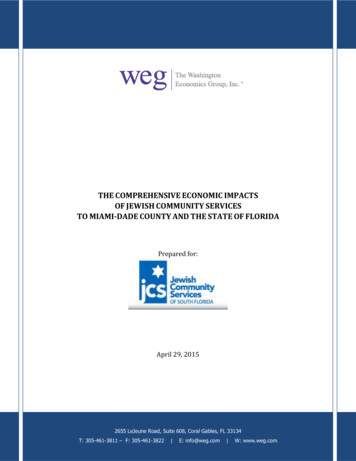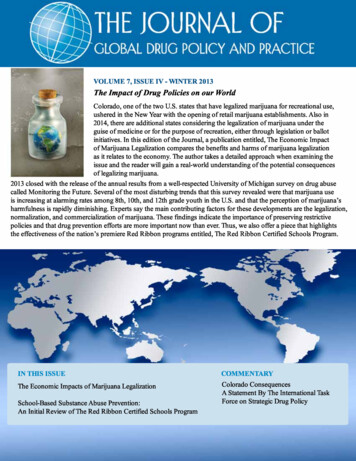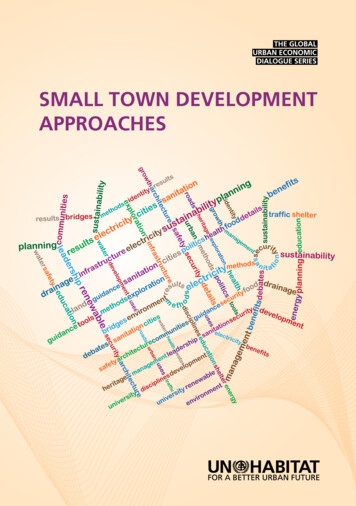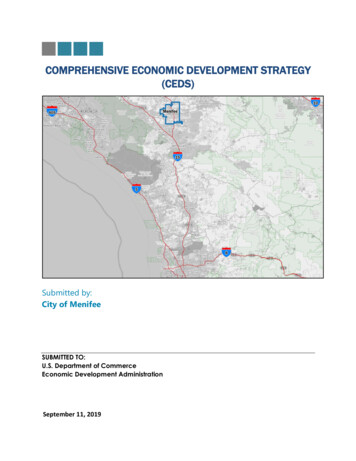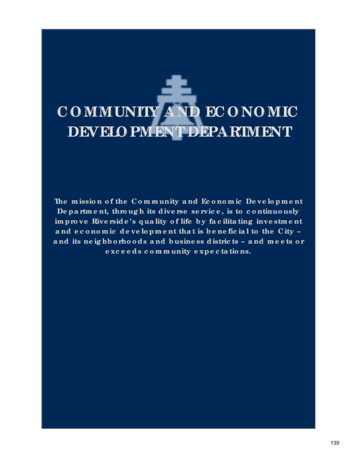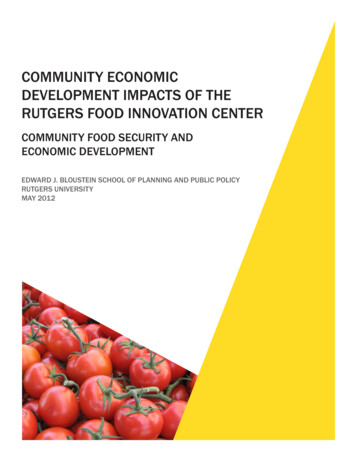
Transcription
COMMUNITY ECONOMICDEVELOPMENT IMPACTS OF THERUTGERS FOOD INNOVATION CENTERCOMMUNITY FOOD SECURITY ANDECONOMIC DEVELOPMENTEDWARD J. BLOUSTEIN SCHOOL OF PLANNING AND PUBLIC POLICYRUTGERS UNIVERSITYMAY 2012
PREPARED for ELIJAH’S PROMISE, THE RUTGERS FOODINNOVATION CENTER, and NEW JERSEY COMMUNITY CAPITALMANY THANKS TOAlena D’Auria, Rutgers UndergraduateMargaret Brennan-Tonetta, Rutgers FICLou Cooperhouse, FIC and F&S Produce Co., Inc.Michael duBois, Rutgers FICLisanne Finston, Elijah’s PromiseDouglas H. Fisher, NJ Secretary of AgricultureLorena Gaibor, Unity Square PartnershipKristina Guttadora, Farmers Against HungerPaul Helms, Elijah’s PromiseDiane Holtaway, Rutgers FICShoufiul Islam, Rutgers FICAlbert Kelly, Mayor of BridgetonWes Kline, NJ Agricultural Experiment StationStephanos Koullias, Western Queens CompostInitiativeRichard Ludescher, Rutgers SEBSTom Manning, NJ Agricultural Experiment StationJean Mahoney, Rutgers FICBruce Master, Rutgers FICNew Brunswick Community Gardening CoalitionNew Brunswick Food AllianceChristina Palassio, The StopGlen Patterson, City of New Brunswick PlanningJack Rabin, NJ Agriculture Experiment StationMark Robson, Rutgers SEBSJaymie Santiago, New Brunswick CommunityFarmers MarketSkylar, Rutgers FICTyler & Scott Thompson, XS SmithTerry & Patrick Viggiano, First FieldsFrank Wong, Rutgers Facilities and Capital PlanningPREPARED BYEdward J. Bloustein School of Planning and Public Policy, Rutgers UniversitySpring 2012 Community Development StudioMax AzzarelloAnthony CapeceMichael CassidyLaura ChamberlainBenjamin FaustSarah FranklinJoshua JensenEmily JoinerBenjamin LogueJacklyn McFarlaneBrandon McKoyMatthew SarsyckiDarius ScottCharlene SharpeCarolyn WorstellFACULTYKathe NewmanAssociate ProfessorDirector of the Ralph W. Voorhees Center for Civic EngagementMay 2012For more information, contact knewman@rutgers.edu
TABLE OF CONTENTSIntroductionThe Rise and Fall of New Jersey’s Food EconomyRutgers RespondsA Food Incubator in Bridgeton, NJWhy Bridgeton?A University EntityEmphasis on Patience and NetworkingGetting StartedFIC Core ServicesRebuilding the New Jersey Food EconomyExpanding MarketsWorkforce DevelopmentLocal Economic DevelopmentSowing Seeds for the ks CitedImage Credits19212224
This page intentionally left blank.
SPRING 2012 COMMUNITY DEVELOPMENT STUDIO, RUTGERS UNIVERSTIYREVITALIZING SOUTH JERSEY’SFOOD ECONOMY: RUTGERSUNIVERSITY FOOD INNOVATIONCENTERBenjamin Faust, Joshua Jensen, Brandon McKoy, Charlene SharpeIntroductionThe Spring 2012 Community Development Studioconducted a community economic developmentimpact study of the Rutgers University Food InnovationCenter (FIC) in Bridgeton, New Jersey. The FIC is a fullservice food incubator, the only food-related businessincubator in the state. The Center provides core foodprocessing business services including businessdevelopment, market testing, product development,networking services, regulatory assistance, qualitycontrol and food safety assistance (Margaret Brennan,February 17, 2012). As a food incubator, the FIC ispart of a growing effort to enhance food-relatedeconomic development. The organization’s missionis to “stimulate and support sustainable economicgrowth and prosperity to the food and agriculturalindustries in the mid-Atlantic region” (Rutgers FoodInnovation Center, 2010). Since its inception in2000, the FIC has provided support to more than1,200 entrepreneurs and businesses, from individualfarmers and start-up food companies to small and midsized food companies and retail food establishments,and has helped companies to develop approximately40 new products (Rutgers Food Innovation Center,2010). Food incubation however, is only a small partof FIC efforts. The FIC is at the center of a campaign torevitalize the food industry in New Jersey.FIC Steam KettleThe FIC has well-quantified and documented impacts from the core business and technical servicesit offers to farmers and food businesses. However, identifying the community economic developmentimpacts of the Center’s programs in areas such as community engagement and network building has5
COMMUNITY FOOD SECURITY AND ECONOMIC DEVELOPMENTbeen more elusive. Thus, this report will chronicle the impacts of FIC’s broader social mission andcatalogue the FIC’s efforts to achieve these goals. To document these less tangible impacts, it isimportant to understand the FIC from conceptualization, through implementation and its future plans.We begin with the history of agriculture in New Jersey. Next we highlight the events under which theFIC was conceived and implemented. Then we document the FIC’s core services and, finally, its effortsto rebuild New Jersey’s food economy infrastructure. We pay special attention throughout, to its effortsto enhance community economic development and food security outcomes. In conclusion, we considerthe FIC’s future in its role as a driver for building the food economy in the state.The Rise and Fall of New Jersey’s Food EconomyNew Jersey, “The Garden State,” was anagricultural powerhouse that grew andprocessed food at rates higher than the nationalaverage during the first half of the twentiethcentury (Adelaja et al, 1996). The state’s foodinnovators created a food-based economyinfrastructure that brought food growers,processors, manufacturers, food scientistsand engineers together. Campbell’s SoupCompany, headquartered in Camden, NewJersey, produced its iconic Campbell’s tomatosoup using the Jersey tomato. Seabrook Farms,located near Bridgeton, pioneered vegetablerefrigeration techniques, making it one of thelargest frozen food processing companies until1976 (Cumberland.nj.us, 2011). In nearbyVineland, Welch’s Grape Juice, developed inFIC Ritter Catsup1869, used a technique to preserve grapejuice without fermenting it, which led to abooming business during Prohibition (City of Vineland, 2008). In the late 1950s, Cumberland Dairy wasestablished and eventually grew to become a refrigerated products distributor and dairy processor forMcDonald’s in the Delaware Valley (Cumberland Dairy, 2012).New Jersey’s accomplishments in agriculture and food processing are all the more impressive given thestate’s relatively small land area. New Jersey ranks 47th of US states in land area, but 4th in the marketvalue of agricultural products sold per acre. New Jersey agricultural production rankings are also quiteimpressive. For instance, the state ranks 2nd in blueberry production, 3rd in bell pepper and cranberryproduction, 4th in head lettuce production and 5th in peach production.However, in recent decades, food manufacturing in New Jersey has declined relative to the rest of thenation, while new housing subdivisions and other real estate development compete for land (Adelajaet al, 1996). New Jersey food manufacturers had delayed the search for cheaper land because of theirneed to stay rooted to their agricultural sources, but in the 1970’s eventually followed the rest of themanufacturing industry out of state. An example is the Campbell’s Soup Company. While Campbell’smaintains its headquarters in Camden, advances in technology, the expansion of the Interstate HighwaySystem, and deregulation of the agricultural industry in the second half of the 20th Century made itfeasible for the company to move its production facilities to cheaper, rural land in Pennsylvania and6
SPRING 2012 COMMUNITY DEVELOPMENT STUDIO, RUTGERS UNIVERSTIYelsewhere outside of New Jersey (Sidorick, 2009). Since the 1970’s, New Jersey’s agricultural industryhas also been under severe pressure as more and more farmland is lost to development each year. Inaddition, a significant challenge for farmers and food processors in an urbanizing state such as NewJersey is the rising cost of doing business. These factors have made it hard for farmers and processorsto compete and, like the rest of the manufacturing sector, New Jersey’s food and agricultural industryhas been in decline.New Jersey agriculture is comprised primarily of small and medium sized farms that have a hard timecompeting with very large growers in other states. Perhaps the most significant threat to the short andlong-term viability of the produce industry in New Jersey are the dramatic changes taking place in theglobal produce marketing system over the last decade. Some of these changes include supplier/retailerconsolidation, demand for 52-week supply, demand for consistent quality and packaging, and expansionof global markets. These changes have transformed the way produce marketing is done nationally andinternationally. The system of marketing produce that currently exists in New Jersey imposes significantconstraints for growers competing in the new global system (Brennan, et. al. 2002). The market foragricultural products is therefore highly competitive. The buyers require nearly perfect produce, whichresults in a significant share of “imperfect” produce that, while fit for eating, cannot be sold.Increasing processing capacity in New Jersey would enable farmers to sell more of those products.Tomatoes, peaches or apples that don’t meet the exact size requirements for individual sale could stillbecome a wonderful tomato sauce, applesauce, or, as one Jersey farmer learned, peach cider (Circle MFarms, 2009). Farmers can also benefit by selling produce directly to in-state processers that may paya higher price. Often food is processed by a third party in order to be re-processed for another purpose.The farmer gets little of the final dollar in this scenario. To improve this, farmers can turn their rawproduce into their own processed products, allowing them to make better use of their crop yield, extendthe economic benefits of the growing season, and capture a better price for their raw produce.Rutgers RespondsConcerned about food industry trends, in 1996, Adesoji Adelaja, chair of the Department of Agricultural,Food and Resource Economics at Rutgers University, conducted a comprehensive study of New Jersey’sagricultural and food industry. The study covered food manufacturing, wholesale distribution, retailsales, and food services. The authors found that small- and medium-sized food companies, as well asgrowers, needed to make changes to become more profitable. Both groups had similar barriers to growthsuch as lack of access to skilled labor pools, lack of access to information on technology innovationsand business development, and not being able to quickly identify new markets, such as those createdby an influx of immigrants to New Jersey (Interview with Margaret Brennan, 2012).Adelaja convened the 1998 New Jersey Food Industry Summit to discuss how the food and agriculturalcommunities, with Rutgers as a partner, might respond to the study’s findings. The summit identifiedtwo complimentary directions and Rutgers created two entities in response. The Rutgers Food PolicyInstitute was created to work on food policy issues such as food and agriculture regulation, land use,tax assessment, minimum wage, food contamination recalls, and food processing issues. The RutgersFood Innovation Center (FIC) was created to provide business and technical services to farmers andfood companies.Margaret Brennan, an agricultural economist at Rutgers, was identified to lead the FIC in 1999 (Interviewwith Margaret Brennan, 2012). Dr. Brennan conducted a literature review and identified national trends7
COMMUNITY FOOD SECURITY AND ECONOMIC DEVELOPMENTand best practices to inform thedevelopment of an innovativeapproach to address the needsidentified in the 1998 summit.Community kitchens and theconcept of business incubationstood out in the researchbecause small businesses andentrepreneurs used communitykitchens to incubate businessideas and develop new foodproducts. Dr. Brennan believed thatshe could develop a multiserviceFigure 1: FIC TImeline, Spring 2012 CD Studiofood based business incubatorthat was an expanded version ofthe traditional community kitchen model (Interview with Margaret Brennan, 2012). Dr. Brennan thenhired a team of national experts to conduct a feasibility study to determine the need for this type ofprogram and the most effective structure for a food-related business incubator in New Jersey. Throughinterviews, focus groups and surveys, the experts engaged stakeholders from communities across thestate and discovered an incredible need for a food business incubator in southern New Jersey (RutgersFood Innovation Center, 2003).A Food Incubator in Bridgeton, NJBridgeton was an attractive location to site the Food Innovation Center because of its central locationamong South Jersey agriculture and food companies (Interview with Margaret Brennan, 2012).Bridgeton and the surrounding region have a storied history of agriculture and food processing. As thefood industry declined, the region became poorer and families, who for generations were intricatelyintertwined with food and agriculture, moved on to new industries. The FIC sought to tie food incubationservices into a broader local revitalization plan, which would help revive the lack of economic activity inand around Bridgeton (Interview with Margaret Brennan, 2012).Why Bridgeton?Bridgeton was appealing for a variety of reasons. A diverse group of Bridgeton constituents andstakeholders including the Bridgeton City School District, Tri-County Community Action Agency,Cumberland County Community College, the Cumberland County Agricultural community, and localbanks were committed to the concept of the Food Innovation Center and provided resources andnetworking support. In anticipation of visits from FIC planners, these partners organized events to bringBridgeton residents together to celebrate the region’s agricultural history and talk about the potentialto recapture it. The local paper highlighted each new FIC event, commenting on the fact that RutgersUniversity had taken an interest in Bridgeton. Regional food entrepreneurs also expressed excitementover the opportunities that the FIC’s creation would bring (Rutgers Food Innovations Center, 2003).The Cumberland County Federal Empowerment Zone (CEZ) supported the FIC’s development bysubsidizing staff salaries and organizational expenses. Empowerment Zones are federal initiativesdesigned to improve severely economic depressed neighborhoods and revitalize economies. The CEZis comprised of certain census tracts in the Vineland-Bridgeton-Millville area. Empowerment Zone8
SPRING 2012 COMMUNITY DEVELOPMENT STUDIO, RUTGERS UNIVERSTIYdesignation provides tax breaks andmillions of dollars in grants and subsidiesto businesses and programs in the zone.The CEZ leadership engaged in newemployment and training opportunities,increased investment within the targetedcommunities, economic developmentinitiatives, educational programs, andcommunity development (CEZ website).The CEZ was an initial and key partner inthe development of the FIC and providedsignificant funding for FIC operations,equipment and construction (RutgersFood Innovations Center, 2003).The city of Bridgeton was also a major FICsupporter. The city government believedthat the FIC would add momentum to theregion’s food industry resurgence. In thelate 1990’s, Bridgeton city governmentdeveloped a food-based economicdevelopment strategy. A Food InnovationPark project was a major part of the plan.The Food Innovation Park is a technology/industrial park dedicated to food industrycompanies. Planning and financing wasthe result of collaboration between the Agricultural Land Use near City of BridgetonCEZ and the city. The idea of a FoodInnovation Park was attractive to Dr. Brennan because she believed it would enable businesses thatgraduated from the FIC business incubator to locate nearby and continue to take advantage of FICservices (Rutgers Food Innovations Center, date unknown).A University EntityHaving Rutgers University behind the project added credibility to the FIC, but being a part of the universitybureaucracy also introduced barriers to implementation. The university initially denied the FIC’s requestto rent office space in downtown Bridgeton. Rutgers University owns large amounts of real estate andit was not common at the time for the university to rent space. In addition, the administration was notconvinced that locating the program in Bridgeton was necessary for its success. Fortunately Dr. Brennansecured grant money for office rental space and a small staff in Bridgeton. Dr. Brennan first tried touse the academic expertise on the main campus to provide FIC services to food and ag businesses,but this did not work well due to the economic development focus of the center rather than research.Dr. Brennan solved this problem by hiring staff with extensive food industry experience and securingfunding through grants to cover the salaries. But there were other challenges. Rutgers had never run abusiness incubator and needed to create rules related to the functions of giving business advice. Aftermany internal staff discussions and meetings with university administration, the decision was made.Helping farmers and small businesses fulfilled the state charter that directed much of the university’swork, which was to make New Jersey a better place for New Jersey residents (Interview with MargaretBrennan, 2012).9
COMMUNITY FOOD SECURITY AND ECONOMIC DEVELOPMENTEmphasis on Patience and NetworkingAs the Center defined new community needs, the organization added staff and services to meet thoseneeds. The FIC hired Lou Cooperhouse, a food consultant with extensive network connections in thefood industry. In February 2002, they hired Diane Holtaway, a business development specialist fromthe Campbell’s Soup Company, and Julie Elmer, a food technologist from McNeil Labs. The feasibilitystudy had highlighted these positions as fundamental to the success of the business incubator (RutgersFood Innovation Center, date unknown). While roots and experience in the food industry was importantfor FIC staff, Dr. Brennan emphasized the importance of the staff’s people skills (Interview withMargaret Brennan, 2012) which were essential in providing excellent customer service and in buildingpartnerships within the community and the food economy. The Center currently employs twelve full timestaff, including a quality assurance and training specialist, a facility manager, a maintenance mechanicand a food production specialist (NLC Presentation 2012).The Center’s position within the University’s framework means that FIC staff must rely heavily on grantsto supplement University funding. The organization has been quite successful at grant writing, withmore than 12 million dollars in grant funding secured to date. The search for grants increases thecenter’s need to network, which, according to Dr. Brennan, continues to be the most integral part ofthe FIC’s success. Not only do these diverse networks attract funders seeking organizations with strongcollaboration ties, but they also validate the relevancy of the FIC’s strategy and mission (Interview withMargaret Brennan, 2012). Throughout this report there will be examples of the various networks andrelationships the FIC has developed. We will also document the impetuous behind creating them, andhow they are helping rebuild the infrastructure for New Jersey’s food economy.Getting StartedThe Center operated out of a rented office in downtown Bridgeton for eight years before designing andbuilding a full-scale facility. This time allowed the center to vet programs and services to better meetclient needs. Ample demand for FIC services assured staff and funders that the organization wascreating programs that consumers desired and in turn guaranteed revenue streams. This approach alsoprovided the opportunity to generate the capital necessary to make financing and operating the facilityfeasible (Rutgers Food Innovations Center, 2010).In the eight years between establishing the small storefront operation and the large full service facility,lines of services were carefully researched and then added to the center’s programmatic portfolio. In2001, the Center hired a director and focused on services related to market research and focus groups.In addition to adding business and technical staff in 2002 and 2003, the Center staff developed astrategy around the construction, capacities and financing of a facility. In 2004, the Center establishedan advisory board comprised of officials and experts from a variety of fields, which guided policyand funding opportunities (Rutgers Food Innovations Center, 2012). In 2007, the carefully craftedplanning strategy produced the funds, space and plans to build a facility to meet the needs of foodentrepreneurs and community members. The 8 million dollar incubation facility was funded entirelythrough grants from community, state and federal sources (Rutgers Food Innovations Center, 2010).Through the facility, the Center offers ever expanding opportunities and services to food entrepreneursand community members.10
SPRING 2012 COMMUNITY DEVELOPMENT STUDIO, RUTGERS UNIVERSTIYFIC Core ServicesThe FIC provides a wide range of business services and flexible processing facilities to help companiesand individuals develop food products. The 23,000 square foot facility in Bridgeton consists of two mainservice areas: a client services area, which provides product development, business, marketing, andfood science analysis services, and a processing area that houses four processing areas dedicatedto a wide range of food processing and packaging needs, and is designed to be shared-use. The FIC’stwo areas are designed to address the simplest to the most complex food processing and businessdevelopment needs. They are available to clients through all stages of the development process, “fromconcept to commercialization” (Interview with Sho Islam, 2012).To assist in the development andmarketing of client concepts,individuals and companies haveaccess to a research library,microbiologyandchemistrylaboratories, sensory evaluation,qualitycontrol,aproductdevelopment research kitchen,and an area for consumer researchand focus groups. The FIC alsoprovides the equipment and spaceto process food products in aFIC Productsnumber of ways, including an areafor cooking, roasting, blanching andsteaming (hot processing); an area to create baked goods and dried products like dehydrated fruit (dryprocessing); the processing of raw produce (cold processing); and the packaging of frozen, refrigerated,or other products requiring controlled environments (cold assembly). These facilities ensure a safe andhealthy food product, and improve the chances that a product will be commercially successful (RutgersFood Innovations Center, 2010). There are fourteen other business incubators in New Jersey, but theFIC is the only one that deals with agriculture and food production. The unique nature of the FIC hascontributed to ever-increasing demand, but Center staff must maintain efficiency and reliability as theygrow.The process of working with farmers and food entrepreneurs “from concept to commercialization”requires more than making sure farmers know how to cook, freeze, wash and package their produce.As part of making sure that interested parties are serious about becoming a food business, the FICrequires all potential clients to take their “Food Business Basics” course which is held quarterly andcosts one hundred and forty-nine dollars. Attendees also receive one hour of free consultation timewith the FIC staff as part of the fee. This process allows the FIC staff to provide broad support tomany potential clients and enables them to clearly explain what taking a product to market entails. Thecourse has proven quite successful in determining which clients are serious about going through therigorous process of creating food products and those who are not, ultimately saving clients and the FICresources. Approximately three quarters of clients who take the course do not return (Interview withMargaret Brennan, 2012).When dealing with food, the FIC views sound preparation and handling processes as imperative andcentral to its mission. Food safety is paramount in creating reliable products that will be successful in the11
COMMUNITY FOOD SECURITY AND ECONOMIC DEVELOPMENTmarketplace and appealing to consumers. Many states have “Cottage Foods” laws that allow residentsto conduct commercial food processing in their homes. New Jersey has a restricted “Cottage Foods”law that prohibits citizens from processing food for commercial purposes in home-based facilities. Dueto this regulation, the FIC is providing a place where commercial businesses and individuals can legallyand safely produce food.To ensure that food products are safe and ready for production, the FIC requires that businesseshave their food supplies arrive several days before production. FIC staff inspects and checks the foodmaterials to insure that everything the client needs arrives, is of the necessary quality, and is safe. Oncethe product is crafted and the recipe is perfected in the test kitchen, the FIC works with the client todevelop a business and marketing plan. This includes assessing where the product will fit within themarket, determining distribution processes, and conducting research to determine the proper pricepoint for the product. Once all of this is completed, actual production of the product for commercialconsumption begins, and the product is shipped out to supermarkets and vendors.Rebuilding the New Jersey Food EconomyMany of the FIC’s economic developments impacts, such as those described in the previous section,can be simply quantified and evaluated. The Center routinely tracks and reports on these tangibleoutcomes such as the popularity of services offered, the number of jobs created and the number ofproducts developed at the FIC facility. The impacts surrounding the Center’s larger effort to rebuild NewJersey’s food economy are more difficult to conceptualize and measure. In this section, we providean overview of FIC efforts to revive New Jersey’s food industry and Bridgeton’s local economy. FICstrategies and initiatives have been divided into three sections: expanding consumer markets for locallyproduced value-added products; developing and using the skills of local residents; and creating localeconomic development impacts. The FIC is attempting to rebuild the food industry in New Jersey, butthey recognize the particular importance of that industry in Bridgeton and South Jersey. While thefollowing categories cover the diversity in scale and impact of FIC ventures, it is vital that their efforts arerecognized as one component of interconnected steps that connect consumers to good food throughrelationships that empower and enrich regions, cities, farmers and food entrepreneurs.Expanding MarketsThe FIC engages in a variety of activities to expand the market for food products in New Jersey. Anexpansion of the market for food generates a larger pool of profits for farmers and food entrepreneurs.To do this the FIC works with food producers to improve quality and traceability. Additionally the FICfacilitates relationships between buyers and producers to increase the population of consumers forlocal products.As part of ensuring food security, the FIC is a liaison to state and federal food regulation agencies. Thereis a USDA office within the FIC facility. The USDA official inspects foods that are coming in to the FIC aswell as food that is outgoing. This ensures food product safety and quality, and it assures consumers ofthe reliability of FIC produced products. As a small scale possessor, the presence of the USDA expandsthe consumer base for FIC products.The New Jersey Department of Agriculture (NJDA) created the “Jersey Fresh” label in 1974 to encouragepeople to purchase Jersey grown produce. As local farmers began investing in value-added productionand consumers sought local goods, a demand grew for labeling processed foods made with New Jersey12
SPRING 2012 COMMUNITY DEVELOPMENT STUDIO, RUTGERS UNIVERSTIYagricultural products. The “Made with Jersey Fresh”labeling program was started by the NJDA in 2009,and the FIC worked with several farmers to createproducts that qualified for this label (Conaboy, 2010).Circle M Farms, a peach grower that uses the “Madewith Jersey Fresh” label on its value added products,included it on the peach cider they developed atthe FIC in 2003 (Circle M Farms, 2009). Kevin andBob Flaim, of the Flaim family farm in Vineland,partnered with the FIC and their Farm-to-Schoolinitiative to create a frozen eggplant cutlet dish forschool lunches in the Vineland School District andfor sale in supermarkets. These products also usethe “Made with Jersey Fresh” label (Conaboy, 2010). FIC product labelsAttaching this label to products allows producers tomeet the increasing demand for local products. Besides helping to develop these and other products,the FIC works with NJDA to support the “Jersey Fresh” label at the National Association of Specialty FoodTrade Show (Personal communication with Diane Holtaway, April 3, 2012).In addition to improving food quality and traceability, the FIC develops business networks, whichenable farmers to sell their products to large institutions. These institutions, such as prisons, hospitals,universities, and schools, have historically relied on manufactured food from national companies. TheCenter seeks to re-route institutional demand for food to the local level, and in the process, get locallygrown food to schools to improve food security. Creating these connections is an example of the FIC’semphasis on networking. The Center has built fruitful relationships with farmers and institutions andthe logical next step is to connect the two groups. The institutions receive locally produced food andthe farmers expand their consumer base. The FIC recognizes that reviving local and regional foodeconomies requires rebuildin
Edward J. Bloustein School of Planning and Public Policy, Rutgers University Spring 2012 Community Development Studio Max Azzarello Anthony Capece . the only food-related business incubator in the state. The Center provides core food- . New Jersey agricultural production rankings are also quite impressive. For instance, the state ranks 2nd .




